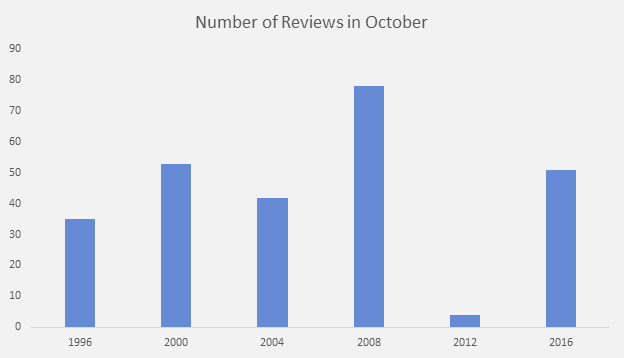Insight
November 4, 2016
Charting Midnight Regulation Before Dawn: October
The month before the election is the perfect example of how politics can influence the Office of Information and Regulatory Affairs (OIRA). In October of 2012, OIRA approved just 4 regulations, in anticipation of controversy before the election. By comparison, in anticipation of President-elect Barack Obama, OIRA approved 78 regulations in October 2012. Last month evidenced little slow-down or surge, with 51 new measures, including 11 economically significant regulations. The average output in 2016 is 45.6 regulations per month. However, OIRA did receive 63 new rulemakings last month, up from 40 in September, so the backlog at the White House could easily increase the pace of rulemaking to well beyond 50 per month.
Through the first ten months of this year, regulators have approved 122 economically significant rulemakings; the next two closest years were 2008 and 2004, when regulators approved just 102 and 72 significant rules during the first ten months. In other words, the White House has approved roughly 20 percent more significant regulatory action than any comparable period since 1996.
With less than a year for President Obama to regulate, this is his midnight year for regulation. Although it’s not the official midnight period yet (defined as the period after Election Day, but before the next president takes office), each month the American Action Forum (AAF) will highlight the final regulatory activity of the administration and compare it to similar times in the past. This monthly series will highlight all the rules leaving the White House scheduled for official publication, all economically significant measures, the length of time for White House review, the number of rules rejected or withdrawn from the rulemaking process, and the monthly cost of federal regulatory activity.
October 2016
Once again, output in 2016 did not top previous presidential election years, as the highwater mark occurred in 2008, with the approval of 78 regulations, including 13 in one day (October 31, 2008); last month the administration approved 51 regulations, up from 44 rules in September. The low-point was 2012, when the White House released just four rules, after releasing 13 rules in September of 2012. This nadir reinforces the anecdotal reports of a pre-election regulatory slowdown in 2012. The chart below tracks overall regulatory activity during these midnight years. It shows 2012 as barely a blip on the graph.
For economically significant measures, October of 2016 was a close second to 2008. OIRA concluded review of 11 significant measures last month; this compares to 12 significant rules in 2008, ten in 2000, and five in 1996. Below are just some of the notable regulations released last month:
- Efficiency Standards for Refrigeration Products
- Treatment of Certain Interests in Corporations
- Student Borrower Defense
- Sound for Hybrid and Electric Vehicles
Despite the output of 11 significant measures, there are still 30 economically significant measures pending review (as of this writing), so agencies continue to add notable rulemakings at the White House. In October, OIRA received 63 additional measures that are still pending review, up from 40 in September of 2012 (including 11 significant rules).
OIRA concluded review of several rules that had been under review for more than 120 days, which is the generally allowed timeframe for White House review under current executive orders. OIRA discharged eight rulemakings that had been under review for more than 120 days.
This October did not surpass all other similar periods during presidential election years for average review times, thanks in part to the incredibly small sample of rules from 2012 (just four). The average review time last month was 59 days, down from 68 days in September; this compares to a low mean of 46 days in October of 2004 The median review time in October 2016 was 42 days.
For comparison, the chart below tracks the average review time since 1996 during midnight years.
Regarding “withdrawn” rulemakings, or measures that agencies and OIRA pull back from review, there was just one in October, for “Presumption of Service Connection for Brain Cancer in Gulf War Veterans.” There were six withdrawn measures in 2008, four in 2004, two in 2000, and one in 1996. There is an obvious disincentive for agencies to withdraw rules this late during an administration and the White House has not aggressively pulled back regulations from review, at least compared to other similar periods.
The Cost
Thanks to AAF’s Reg Rodeo tool, the public can track regulatory costs and paperwork burdens over time, including data on major rules, Dodd-Frank, and the Affordable Care Act. In October 2016, regulators finalized $38.6 billion in costs, up from $10.1 billion in September. How does this compare to other similar periods? Although not a presidential election year, in October 2015, regulators published $15 billion in costs. In terms of paperwork, regulators published five million final hours this October, compared to October 2015, with 14.5 million hours.
Finally, there is the ultimate question of President Obama’s regulatory legacy. Through this point in his presidency (October of 2008), President George W. Bush had issued 462 major rules. By contrast, President Obama has issued 636, or 37 percent more than his predecessor. AAF will continue to publish monthly updates of similar periods in history.












